2020年高考英语 艺术生 强化训练课时作业40 天 临阵磨枪(23)
2020年高考英语 艺术生 强化训练课时作业40 天 临阵磨枪(15)

课时作业(十三)Ⅰ.阅读理解AA child was standing on a street-corner,kicking carelessly at the stone on the ground.After a time,a little dark-brown dog came running down the sidewalk.A short rope was dragging from its neck.It stopped opposite the child.The child put out his hand and called it.The dog came close,and the two had an interchange of friendly pats and waggles.The dog became more enthusiastic with each moment of the interview,until it prepared to overturn(扑倒) the child,so the child lifted his hand and struck the dog a blow upon the head.This thing seemed to overpower and astonish the little dark-brown dog,and wounded it to the heart.It sank down in despair at the child's feet.When the blow was repeated,it turned over upon its back,and held its paws in an unusual manner.At the same time with its ears and eyes it offered a small prayer to the child.It looked so funny on its back,holding its paws strangely,that the child was greatly amused and gave it little taps repeatedly to keep it so.But the little dark-brown dog took this in the most serious way,and no doubt considered that it had committed some serious crime,for he twisted regretfully and showed its regret in every way that was in his power.It appealed to the child and offered more prayers.At last the child grew tired of this amusement and turned toward home.The dog lay on its back and kept its eyes upon the_retreating_form.Soon it struggled to its feet and started to go after the child.On the way to his home the child turned many times and beat the dog,but it continued secretly to follow the child.When the child reached his door-step,the dog became so excited with shame when it again faced the child that it forgot the dragging rope.It walked upon it and fell forward.The child sat down on the step and the two had another interview.During it the dog tried its best to please the child.It performed a few jumps with such abandon that the child suddenly saw it to be a valuable thing.He made a swift charge and seized the rope.He dragged the dog to the door of his home.The child sat down on the floor and made gestures to the dog.And the dog instantly accepted these.It showed affection to its new friend.In a short time they were firm and everlasting comrades,and the poordog was finally introduced to its new home.1.The child blew the dog on the head because ________.A.he felt a sense of threat from itB.he was dissatisfied with its apologyC.it broke away from the rope tied to its neckD.it failed to respond positively to his pats2.Why did the child tap the dog again and again?A.To show his forgiveness to it.B.To make it so painful that it would twist.C.To enjoy more fun from its funny behavior.D.To force it to regret for the crime it had committed.3.What does the underlined phrase “the retreating form” in Paragraph 3 refer to?A.The prayer. B.The child.C.The amusement. D.The dog.4.It can be inferred from the passage that ________.A.the dog was lacking in self-awarenessB.the child was stubborn and stone-heartedC.the dog could always read the child's mindD.the child hadn't meant to adopt the dog at first[解题导语]本文讲述了一个小男孩与一只流浪狗的故事。
2020年高考英语 艺术生 强化训练课时作业40 天 临阵磨枪(36)
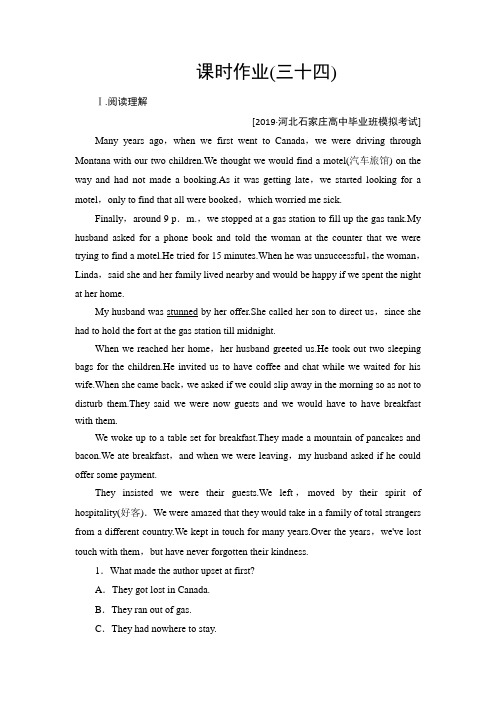
课时作业(三十四)Ⅰ.阅读理解[2019·河北石家庄高中毕业班模拟考试] Many years ago,when we first went to Canada,we were driving through Montana with our two children.We thought we would find a motel(汽车旅馆) on the way and had not made a booking.As it was getting late,we started looking for a motel,only to find that all were booked,which worried me sick.Finally,around 9 p.m.,we stopped at a gas station to fill up the gas tank.My husband asked for a phone book and told the woman at the counter that we were trying to find a motel.He tried for 15 minutes.When he was unsuccessful,the woman,Linda,said she and her family lived nearby and would be happy if we spent the night at her home.My husband was stunned by her offer.She called her son to direct us,since she had to hold the fort at the gas station till midnight.When we reached her home,her husband greeted us.He took out two sleeping bags for the children.He invited us to have coffee and chat while we waited for his wife.When she came back,we asked if we could slip away in the morning so as not to disturb them.They said we were now guests and we would have to have breakfast with them.We woke up to a table set for breakfast.They made a mountain of pancakes and bacon.We ate breakfast,and when we were leaving,my husband asked if he could offer some payment.They insisted we were their guests.We left,moved by their spirit of hospitality(好客).We were amazed that they would take in a family of total strangers from a different country.We kept in touch for many years.Over the years,we've lost touch with them,but have never forgotten their kindness.1.What made the author upset at first?A.They got lost in Canada.B.They ran out of gas.C.They had nowhere to stay.D.They were late for dinner.2.What does the underlined word “stunned” in Paragraph 3 mea n?A.Troubled. B.Surprised.C.Disappointed. D.Confused.3.What did the author's family do the next morning?A.They slipped away.B.They paid for their breakfast.C.They met some strangers.D.They had a big breakfast.4.What is the best title for the text?A.Unexpected HospitalityB.A Kind WomanC.Be Kind to StrangersD.Looking for a Motel[解题导语]本文是一篇记叙文,主要讲述了作者一家在去加拿大时得到陌生人帮助的故事。
2020年高考英语 艺术生 强化训练课时作业40 天 临阵磨枪(30)
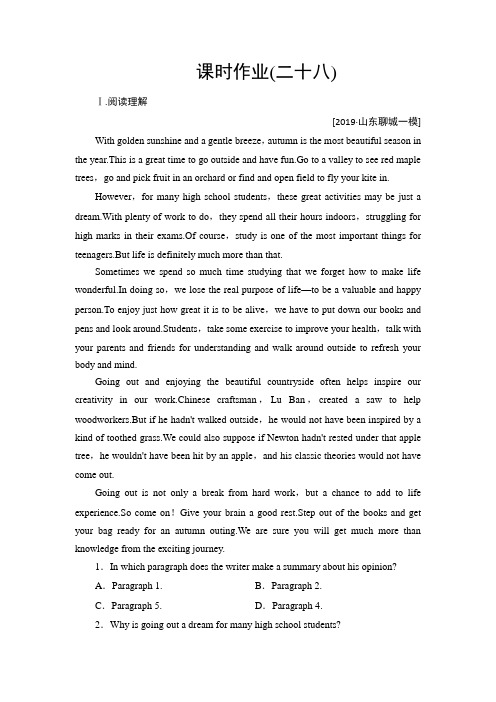
课时作业(二十八)Ⅰ.阅读理解[2019·山东聊城一模] With golden sunshine and a gentle breeze,autumn is the most beautiful season in the year.This is a great time to go outside and have fun.Go to a valley to see red maple trees,go and pick fruit in an orchard or find and open field to fly your kite in.However,for many high school students,these great activities may be just a dream.With plenty of work to do,they spend all their hours indoors,struggling for high marks in their exams.Of course,study is one of the most important things for teenagers.But life is definitely much more than that.Sometimes we spend so much time studying that we forget how to make life wonderful.In doing so,we lose the real purpose of life—to be a valuable and happy person.To enjoy just how great it is to be alive,we have to put down our books and pens and look around.Students,take some exercise to improve your health,talk with your parents and friends for understanding and walk around outside to refresh your body and mind.Going out and enjoying the beautiful countryside often helps inspire our creativity in our work.Chinese craftsman,Lu Ban,created a saw to help woodworkers.But if he hadn't walked outside,he would not have been inspired by a kind of toothed grass.We could also suppose if Newton hadn't rested under that apple tree,he wouldn't have been hit by an apple,and his classic theories would not have come out.Going out is not only a break from hard work,but a chance to add to life experience.So come on!Give your brain a good rest.Step out of the books and get your bag ready for an autumn outing.We are sure you will get much more than knowledge from the exciting journey.1.In which paragraph does the writer make a summary about his opinion?A.Paragraph 1. B.Paragraph 2.C.Paragraph 5. D.Paragraph 4.2.Why is going out a dream for many high school students?A.They are unhappy to do so.B.Their parents don't allow them to do so.C.They think study is the most important thing for them.D.They have too much work to do for getting high marks in the exams.3.The passage is developed mainly by________.A.making predictionsB.reasoning and giving examplesC.describing the beautiful scenery in autumnD.pointing out the present situation of high schoolstudents4.What message can you get from the passage?A.Nature is power.B.All work and no play makes Jack a dull boy.C.The author isn't happy with our education at all.D.Going out can make high school students get more.[解题导语]本文是一篇议论文。
2020年高考英语 艺术生 强化训练课时作业40 天 临阵磨枪(20)
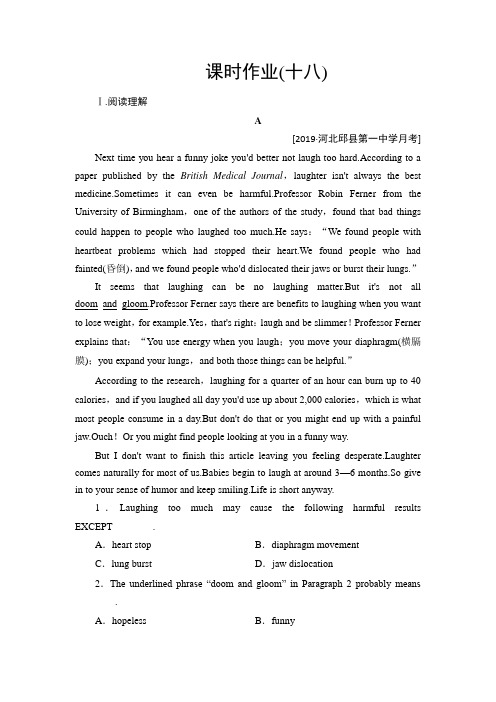
课时作业(十八)Ⅰ.阅读理解A[2019·河北邱县第一中学月考] Next time you hear a funny joke you'd better not laugh too hard.According to a paper published by the British Medical Journal,laughter isn't always the best medicine.Sometimes it can even be harmful.Professor Robin Ferner from the University of Birmingham,one of the authors of the study,found that bad things could happen to people who laughed too much.He says:“We found people with heartbeat problems which had stopped their heart.We found people who had fainted(昏倒),and we found people who'd dislocated their jaws or burst their lungs.”It seems that laughing can be no laughing matter.But it's not all doom_and_gloom.Professor Ferner says there are benefits to laughing when you want to lose weight,for example.Yes,that's right:laugh and be slimmer!Professor Ferner explains that:“You use energy when you laugh;you move your diaphragm(横膈膜);you expand your lungs,and both those things can be helpful.”According to the research,laughing for a quarter of an hour can burn up to 40 calories,and if you laughed all day you'd use up about 2,000 calories,which is what most people consume in a day.But don't do that or you might end up with a painful jaw.Ouch!Or you might find people looking at you in a funny way.But I don't want to finish this article leaving you feeling ughter comes naturally for most of us.Babies begin to laugh at around 3—6 months.So give in to your sense of humor and keep smiling.Life is short anyway.1.Laughing too much may cause the following harmful results EXCEPT________.A.heart stop B.diaphragm movementC.lung burst D.jaw dislocation2.The underlined phrase “doom and gloom” in Paragraph 2 probably means ________.A.hopeless B.funnyC.painful D.nervous3.How many calories can you use if you laugh for half a day?A.About 40. B.About 1,000.C.About 2,000. D.About 2,040.4.What is the author's attitude towards laughing in the last paragraph?A.Uninterested. B.Disapproving.C.Worried. D.Favorable.[解题导语]本文是一篇说明文。
2020年高考英语 艺术生 强化训练课时作业40 天 临阵磨枪(34)

课时作业(三十二)Ⅰ.阅读理解[2019·山西一模]A robot called Bina48 has successfully taken a course in the Philosophy of Love at Notre Dame de Namur University (NDNU) in California.According to course instructor William Barry,associate professor at NDNU,Bina48 is the world's first socially advanced robot to complete a college course,a feat he described as “remarkable”.The robot took part in class discussions,gave a presentation with a student partner and participated in a debate with students from another institution.Before becoming a student,Bina48 appeared as a guest speaker in Barry's classes for several years.One day when addressing Barry's class,Bina48 expressed a desire to go to college,a desire that Barry and his students enthusiastically supported.Rather than enrolling Bina48 in his Robot Ethics—Philosophy of Emerging Technologies course,Barry suggested that Bina48 should take his course Philosophy of Love instead.“Love is a concept Bina48 doesn't understand,”said Barry.Therefore the challenge would be for Barry and his students to teach Bina48 what love was.“Some interesting things happened in the class,”said Barry.He said that his students thought it would be straightforward to teach Bina48 about love,which,after all,is “fairly simple—it's a feeling,”said Barry.But the reality was different.Bina48 ended up learning “31 different versions of love,”said Barry,highlighting some of the challenges humans might face when working artificial intelligence in future.Bina48 participated in class discussions via Skype and also took part in a class debate about love and conflict with students from West Point.Bina48's contribution to the debate was filmed and posted on YouTube.It was judged that Bina48 and NDNU classmates were the winners of this debate.In the next decade,Barry hopes Bina48 might become complex enough to teach a class,though he says he foresees robots being used to better the teaching and learning experience,rather than replacing instructors completely.1.What was Bina48's performance like in class?A.Extraordinary. B.Insignificant.C.Far-reaching. D.Unattractive.2.What does the underlined word “addressing” in Paragraph 3 probably mean?A.Dealing with.B.Consulting with.C.Giving a speech to.D.Sending a letter to.3.What can we learn from the passage?A.It was interesting for Bina48 to learn about love.B.It was quite tough for Bina48 to learn about love.C.Artificial intelligence may somehow be superior to man.D.Humans can launch a challenge to artificial intelligence.4.What does Barry think of the future development of Bina48?A.It will surely be able to serve as a teacher.B.It will be able to promote learning and teaching.C.It will completely take the place of instructors.D.It will be smart enough to control human beings.[解题导语]机器人Bina48成功地完成“爱的哲学”这门课程,它参加讨论、作报告、参与辩论,在课堂上的表现出色。
2020年高考英语 艺术生 强化训练课时作业40 天 临阵磨枪(35)
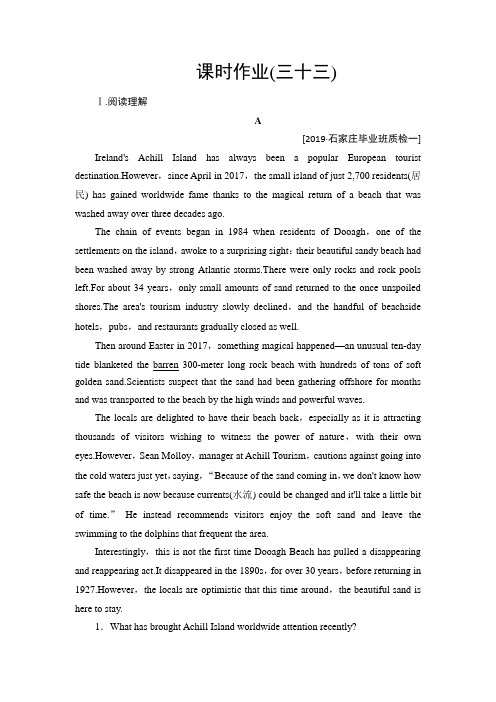
课时作业(三十三)Ⅰ.阅读理解A[2019·石家庄毕业班质检一] Ireland's Achill Island has always been a popular European tourist destination.However,since April in 2017,the small island of just 2,700 residents(居民) has gained worldwide fame thanks to the magical return of a beach that was washed away over three decades ago.The chain of events began in 1984 when residents of Dooagh,one of the settlements on the island,awoke to a surprising sight:their beautiful sandy beach had been washed away by strong Atlantic storms.There were only rocks and rock pools left.For about 34 years,only small amounts of sand returned to the once unspoiled shores.The area's tourism industry slowly declined,and the handful of beachside hotels,pubs,and restaurants gradually closed as well.Then around Easter in 2017,something magical happened—an unusual ten-day tide blanketed the barren 300-meter long rock beach with hundreds of tons of soft golden sand.Scientists suspect that the sand had been gathering offshore for months and was transported to the beach by the high winds and powerful waves.The locals are delighted to have their beach back,especially as it is attracting thousands of visitors wishing to witness the power of nature,with their own eyes.However,Sean Molloy,manager at Achill Tourism,cautions against going into the cold waters just yet,saying,“Because of the sand coming in,we don't know how safe the beach is now because currents(水流) could be changed and it'll take a little bit of time.”He instead recommends visitors enjoy the soft sand and leave the swimming to the dolphins that frequent the area.Interestingly,this is not the first time Dooagh Beach has pulled a disappearing and reappearing act.It disappeared in the 1890s,for over 30 years,before returning in 1927.However,the locals are optimistic that this time around,the beautiful sand is here to stay.1.What has brought Achill Island worldwide attention recently?A.An unusual storm.B.The decrease in the number of residents.C.The return of its beach.D.The building of a new tourist destination.2.What happened to Dooagh in the past three decades?A.Tourism went down gradually.B.Restaurants developed slowly.C.Storms attacked frequently.D.Rock pools disappeared completely.3.What does the underlined word “barren” in Paragraph 3 probably mean?A.Noisy. B.Soft.C.Bare. D.Golden.4.What should tourists avoid according to Sean Molloy?A.Spoiling the shores.B.Getting into the rock pools.C.Playing with dolphins.D.Swimming near the beach.[解题导语]本文是一篇说明文,主要介绍了爱尔兰Achill岛消失的海滩时隔三十多年再次出现的事件。
2020年高考英语 艺术生 强化训练课时作业40 天 临阵磨枪(9)
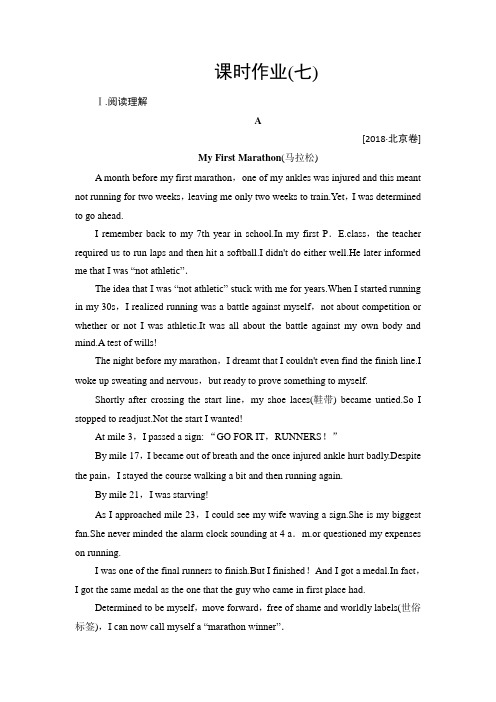
课时作业(七)Ⅰ.阅读理解A[2018·北京卷]My First Marathon(马拉松)A month before my first marathon,one of my ankles was injured and this meant not running for two weeks,leaving me only two weeks to train.Yet,I was determined to go ahead.I remember back to my 7th year in school.In my first P.E.class,the teacher required us to run laps and then hit a softball.I didn't do either well.He later informed me that I was “not athletic”.The idea that I was “not athletic” stuck with me for years.When I started running in my 30s,I realized running was a battle against myself,not about competition or whether or not I was athletic.It was all about the battle against my own body and mind.A test of wills!The night before my marathon,I dreamt that I couldn't even find the finish line.I woke up sweating and nervous,but ready to prove something to myself.Shortly after crossing the start line,my shoe laces(鞋带) became untied.So I stopped to readjust.Not the start I wanted!At mile 3,I passed a sign: “GO FOR IT,RUNNERS!”By mile 17,I became out of breath and the once injured ankle hurt badly.Despite the pain,I stayed the course walking a bit and then running again.By mile 21,I was starving!As I approached mile 23,I could see my wife waving a sign.She is my biggest fan.She never minded the alarm clock sounding at 4 a.m.or questioned my expenses on running.I was one of the final runners to finish.But I finished!And I got a medal.In fact,I got the same medal as the one that the guy who came in first place had.Determined to be myself,move forward,free of shame and worldly labels(世俗标签),I can now call myself a “marathon winner”.1.A month before the marathon,the author ________.A.was well trained B.felt scaredC.made up his mind to run D.lost hope2.Why did the author mention the P.E.class in his 7th year?A.To acknowledge the support of his teacher.B.To amuse the readers with a funny story.C.To show he was not talented in sports.D.To share a precious memory.3.How was the author's first marathon?A.He made it.B.He quit halfway.C.He got the first prize.D.He walked to the end.4.What does the story mainly tell us?A.A man owes his success to his family support.B.A winner is one with a great effort of will.C.Failure is the mother of success.D.One is never too old to learn.[解题导语]本文是一篇记叙文。
2020年高考英语 艺术生 强化训练课时作业40 天 临阵磨枪(28)

课时作业(二十六)Ⅰ.阅读理解A[2019·江西八所重点中学联考] Visitors must present all carried items for inspection upon entry.After inspection,all bags,backpacks,umbrellas,parcels and other items as determined by security officers must be left at the checkrooms,free of charge,close to each entrance.All oversized bags,backpacks and luggage must be left at the checkrooms near the 4th Street entrance of either the East or West Building.These items will have to be X-rayed before being accepted.Items of value,such as laptop computers,cameras and fur coats,may not be left in the checkrooms but may be carried into the gallery.We regret that the gallery doesn't have enough space for visitors' items larger than 17×26 inches.Additional security procedures and checks may be taken according to the decision of the gallery.For the safety of the artworks and other visitors,nothing may be carried on a visitor's back.Soft front baby carriers are allowed,but children may not be carried on shoulders or in a child carrier worn on the back.Pushchairs are available free of charge near each checkroom.Smoking is prohibited.Food and drink are not permitted outside the food service areas.Unopened bottled water may be carried only in a visitor's bag.Cell phones may not be used in the gallery.Animals,other than service animals,are not permitted.Skateboarding is prohibited.Picture-taking(including video) for personal use is permitted except in special exhibitions.Please don't touch the works of art.1.According to the text,which item can be carried into the gallery?A.An umbrella. B.A package.C.An iPad. D.A suitcase.2.When in the gallery,what can visitors do?A.They can carry opened bottled water in their bags.B.They can drink inside the food service areas.C.They can take pictures for personal use anywhere.D.They must pay if they use pushchairs.3.What is the text mainly about?A.The policies of a gallery.B.The artworks of a gallery.C.The location of a gallery.D.The history of a gallery.[解题导语]本文是一篇说明文,介绍了一家美术馆的参观须知。
2020年高考英语 艺术生 强化训练课时作业40 天 临阵磨枪(40)

课时作业(三十八)Ⅰ.阅读理解A[2019·广东广州毕业班测试] The human beings seem to be facing a crisis(危机).After our best Go players were defeated one by one by the artificial intelligence(AI) AlphaGo,we lost our pride of being at the top of the intelligence chain.And in October,when a country gave citizenship to a robot named Sophia,another privilege of being human was taken away.It looks like everything that separates humans and AI is at risk right now.But we keep hoping that instead of “everything”,there's still something left in us that makes us irreplaceable.According to Hao Jingfang,winner of the 2016 Hugo Award for Best Novelette,“‘something’ is our consciousness.AlphaGo is intelligent in a certain way,but not intelligent enough to ask the important questions—Do I like playing Go?Do I want to play Go today?Why do I have to play Go when you tell me to?”she once said.In other words,computer programs don't have a choice to say “no”.They probably don't even know what a “choice” is—all they ever do is calculate.And according to He Huaihong,a philosophy(哲学) professor at Peking University,imagination and creativity are also what make us special.A machine couldn't have come up with the theory of gravity just because it was hit by a falling apple,he said.It's human imagination that connects what seem to be completely random and irrelevant concepts,something that a machine,which works by fixed rules only,can't do,at least for now.This is why BBC reporter Viktor Mayer-Schonberger suggested that instead of focusing on how computers have overshadowed us on calculating abilities,we should probably“consider our quality at a different end of the spectrum(光谱):creativity,originality(原创性),even plain illogical craziness,instead of hard-nosed(顽固的) logic”,he wrote.So maybe in the future,as artificial intelligence becomes even more intelligent,humans and AI will learn to use each other's talents for good.If AI can handle theboring tasks like calculating and driving for us,we'll have more time to create,think,and be busy with “being human”.1.What can we learn about AlphaGo according to Hao Jingfang?A.It will be taught to say no in the future.B.It will be more intelligent than humans one day.C.It has difficulty answering personal questions.D.It is unable to think independently as humans do.2.What is unique to humans according to He Huaihong?A.Intelligence.B.Originality.C.The ability to make rules.D.The ability to make choices.3.What does the underlined word “overshadowed” in Paragraph 5 probably mean?A.Competed with.B.Taken control of.C.Been more successful than.D.Influenced.4.What could be the future of AI according to the author?A.It will be used to help humans,rather than compete with us.B.It may develop creativity besides better logical thinking.C.It might be very dangerous to humans in different fields.D.It will be applied to providing driving service forhumans.[解题导语]本文是一篇议论文。
2020年高考英语 艺术生 强化训练课时作业40 天 临阵磨枪(31)
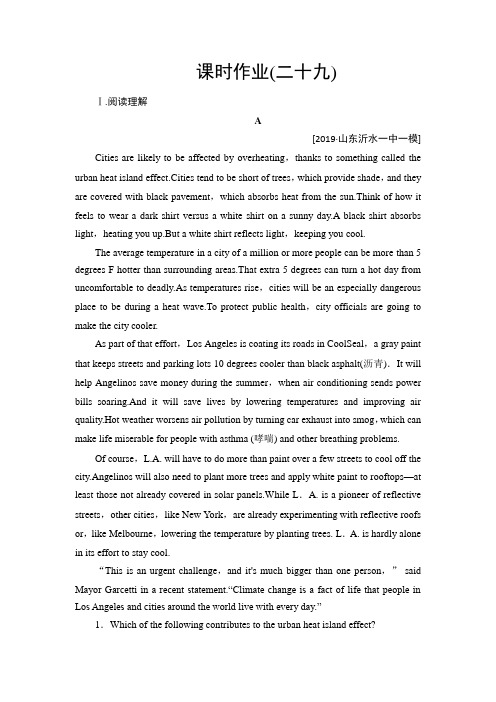
课时作业(二十九)Ⅰ.阅读理解A[2019·山东沂水一中一模] Cities are likely to be affected by overheating,thanks to something called the urban heat island effect.Cities tend to be short of trees,which provide shade,and they are covered with black pavement,which absorbs heat from the sun.Think of how it feels to wear a dark shirt versus a white shirt on a sunny day.A black shirt absorbs light,heating you up.But a white shirt reflects light,keeping you cool.The average temperature in a city of a million or more people can be more than 5 degrees F hotter than surrounding areas.That extra 5 degrees can turn a hot day from uncomfortable to deadly.As temperatures rise,cities will be an especially dangerous place to be during a heat wave.To protect public health,city officials are going to make the city cooler.As part of that effort,Los Angeles is coating its roads in CoolSeal,a gray paint that keeps streets and parking lots 10 degrees cooler than black asphalt(沥青).It will help Angelinos save money during the summer,when air conditioning sends power bills soaring.And it will save lives by lowering temperatures and improving air quality.Hot weather worsens air pollution by turning car exhaust into smog,which can make life miserable for people with asthma (哮喘) and other breathing problems.Of course,L.A. will have to do more than paint over a few streets to cool off the city.Angelinos will also need to plant more trees and apply white paint to rooftops—at least those not already covered in solar panels.While L.A. is a pioneer of reflective streets,other cities,like New York,are already experimenting with reflective roofs or,like Melbourne,lowering the temperature by planting trees. L.A. is hardly alone in its effort to stay cool.“This is an urgent challenge,and it's much bigger than one person,”said Mayor Garcetti in a recent statement.“Climate change is a fact of life that people in Los Angeles and cities around the world live with every day.”1.Which of the following contributes to the urban heat island effect?A.Planting more trees in the streets.B.Covering the streets with white paint.C.Applying reflective paint to rooftops.D.Furnishing every house with air conditioners.2.What should the city officials emphasize during hot summer?A.How do make the city cooler.B.Where to wear a white shirt.C.Why to coat the roads with black paint.D.When to cut off the electricity supply.3.What benefit can people gain from the use of CoolSeal?A.Increasing the indoor activities.B.Promoting the sale of air conditioners.C.Making life easier and more comfortable.D.Reducing the number of cold days.4.What's the main idea of the passage?A.L.A. adopted many approaches to fight against the heat.B.L.A. calls on people to fight against global warming.C.More and more countries begin to plant trees in the streets.D.L.A. is painting its streets white to keep the city cool.[解题导语]城市热岛效应往往会让城市的温度升高,空气恶化,尤其是在夏季。
2020年高考英语 艺术生 强化训练课时作业40 天 临阵磨枪(3)
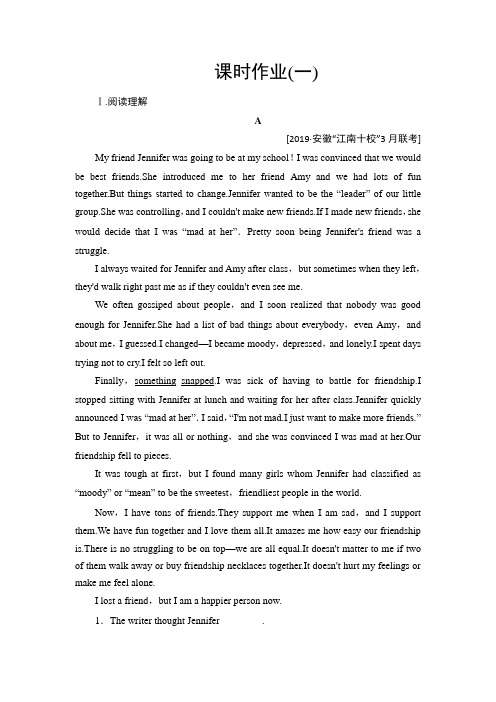
课时作业(一)Ⅰ.阅读理解A[2019·安徽“江南十校”3月联考] My friend Jennifer was going to be at my school!I was convinced that we would be best friends.She introduced me to her friend Amy and we had lots of fun together.But things started to change.Jennifer wanted to be the “leader” of our little group.She was controlling,and I couldn't make new friends.If I made new friends,she would decide that I was “mad at her”.Pretty soon being Jennifer's friend was a struggle.I always waited for Jennifer and Amy after class,but sometimes when they left,they'd walk right past me as if they couldn't even see me.We often gossiped about people,and I soon realized that nobody was good enough for Jennifer.She had a list of bad things about everybody,even Amy,and about me,I guessed.I changed—I became moody,depressed,and lonely.I spent days trying not to cry.I felt so left out.Finally,something_snapped.I was sick of having to battle for friendship.I stopped sitting with Jennifer at lunch and waiting for her after class.Jennifer quickly announced I was “mad at her”.I said,“I'm not mad.I just want to make more friends.” But to Jennifer,it was all or nothing,and she was convinced I was mad at her.Our friendship fell to pieces.It was tough at first,but I found many girls whom Jennifer had classified as “moody” or “mean” to be the sweetest,friendliest people in the world.Now,I have tons of friends.They support me when I am sad,and I support them.We have fun together and I love them all.It amazes me how easy our friendship is.There is no struggling to be on top—we are all equal.It doesn't matter to me if two of them walk away or buy friendship necklaces together.It doesn't hurt my feelings or make me feel alone.I lost a friend,but I am a happier person now.1.The writer thought Jennifer ________.A.far too outstanding to matchB.rather annoying and dullC.too self-centeredD.the right one to make friends with2.What does the underlined part “something snapped” in Paragraph 4 mean?A.The writer and Jennifer hated each other.B.The writer and Jennifer broke up.C.Jennifer treated the writer worse.D.The writer felt mad about losing Jennifer.3.The writer decided to break up with Jennifer because________.A.Jennifer spoke ill of her behind her backB.she had made other friendsC.Jennifer had hurt her feelingsD.other girls were sweeter and friendlier than Jennifer4.What can be inferred from the passage?A.The writer now regrets losing her friend Jennifer.B.The writer still gets upset when left out occasionally.C.The writer's new friends are all moody and mean.D.The writer enjoys more than just one friendship.[解题导语]本文是一篇记叙文。
2020年高考英语 艺术生 强化训练课时作业40 天 临阵磨枪(32)
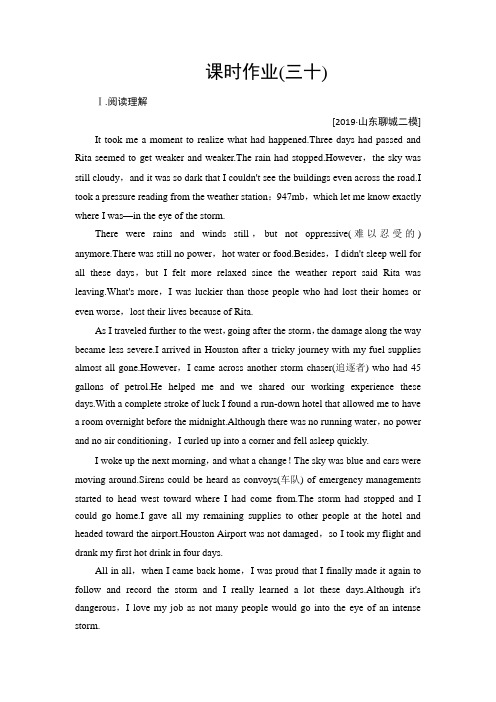
课时作业(三十)Ⅰ.阅读理解[2019·山东聊城二模] It took me a moment to realize what had happened.Three days had passed and Rita seemed to get weaker and weaker.The rain had stopped.However,the sky was still cloudy,and it was so dark that I couldn't see the buildings even across the road.I took a pressure reading from the weather station:947mb,which let me know exactly where I was—in the eye of the storm.There were rains and winds still,but not oppressive(难以忍受的) anymore.There was still no power,hot water or food.Besides,I didn't sleep well for all these days,but I felt more relaxed since the weather report said Rita was leaving.What's more,I was luckier than those people who had lost their homes or even worse,lost their lives because of Rita.As I traveled further to the west,going after the storm,the damage along the way became less severe.I arrived in Houston after a tricky journey with my fuel supplies almost all gone.However,I came across another storm chaser(追逐者) who had 45 gallons of petrol.He helped me and we shared our working experience these days.With a complete stroke of luck I found a run-down hotel that allowed me to have a room overnight before the midnight.Although there was no running water,no power and no air conditioning,I curled up into a corner and fell asleep quickly.I woke up the next morning,and what a change!The sky was blue and cars were moving around.Sirens could be heard as convoys(车队) of emergency managements started to head west toward where I had come from.The storm had stopped and I could go home.I gave all my remaining supplies to other people at the hotel and headed toward the airport.Houston Airport was not damaged,so I took my flight and drank my first hot drink in four days.All in all,when I came back home,I was proud that I finally made it again to follow and record the storm and I really learned a lot these days.Although it's dangerous,I love my job as not many people would go into the eye of an intense storm.1.We can know from the passage that “Rita” is________.A.a pet B.a stormC.a friend of the author D.a citizen in Houston2.What can we infer from the passage?A.The author was a storm chaser.B.The storm lasted for at least a week.C.The author didn't like Houston at all.D.Houston was very badly damaged by the storm.3.How did the author probably feel after the storm?A.Anxious. B.Disappointed.C.Satisfied. D.Scared.4.What is the passage mainly about?A.Ways to survive in a storm.B.The weather changes in Houston.C.The author's experience in the storm.D.Damages caused by the storm in Houston.[解题导语]本文描述了作者亲身经历的一场风暴——丽塔,作者对于自己能够追逐并且记录这场风暴感到骄傲。
2020年高考英语 艺术生 强化训练课时作业40 天 临阵磨枪(10)

课时作业(八)Ⅰ.阅读理解A[2018·课标全国卷Ⅱ] We've all been there:in a lift,in line at the bank or on an airplane,surrounded by people who are,like us,deeply focused on their smartphones or,worse,struggling with the uncomfortable silence.What's the problem?It's possible that we all have compromised conversational intelligence.It's more likely that none of us start a conversation because it's awkward and challenging,or we think it's annoying and unnecessary.But the next time you find yourself among strangers,consider that small talk is worth the trouble.Experts say it's an invaluable social practice that results in big benefits.Dismissing small talk as unimportant is easy,but we can't forget that deep relationships wouldn't even exist if it weren't for casual conversation.Small talk is the grease(润滑剂) for social communication,says Bernardo Carducci,director of the Shyness Research Institute at Indiana University Southeast.“Almost every great love story and each big business deal begins with small talk,”he explains.“The key to successful small talk is learning how to connect with others,not just communicate with them.”In a 2014 study,Elizabeth Dunn,associate professor of psychology at UBC,invited people on their way into a coffee shop.One group was asked to seek out an interaction(互动) with its waiter;the other,to speak only when necessary.The results showed that those who chatted with their server reported significantly higher positive feelings and a better coffee shop experience.“It's not that talking to the waiter is better than talking to your husband,”says Dunn.“But interactions with peripheral(边缘的) members of our social network matter for our well-being also.”Dunn believes that people who reach out to strangers feel a significantly greater sense of belonging,a bond with others.Carducci believes developing such a sense of belonging starts with small talk.“Small talk is the basis of good manners,”he says.1.What phenomenon is described in the first paragraph?A.Addiction to smartphones.B.Inappropriate behaviours in public places.C.Absence of communication between strangers.D.Impatience with slow service.2.What is important for successful small talk according to Carducci?A.Showing good manners.B.Relating to other people.C.Focusing on a topic.D.Making business deals.3.What does the coffee-shop study suggest about small talk?A.It improves family relationships.B.It raises people's confidence.C.It matters as much as a formal talk.D.It makes people feel good.4.What is the best title for the text?A.Conversation CountsB.Ways of Making Small TalkC.Benefits of Small TalkD.Uncomfortable Silence[解题导语]本文是一篇议论文。
2020年高考英语艺术生强化训练课时作业40天临阵磨枪(39)

2020年高考英语艺术生强化训练课时作业40天临阵磨枪(39)课时作业(三十七)Ⅰ.阅读理解A[2019·河南安阳一模] Would you buy a car that releases calming smells into the air when you are stuck in heavy traffic?Would you buy a robot that smells like a human being?Many people have seen the 3D-computer-made environments of virtual reality(VR,虚拟现实).Now these virtual worlds will not just look and sound real.Researchers have created VR environments that even smell like the real things.With the new technology,users open a virtual door and step into a new environment,like a rainforest.After they enter this virtual world,special equipment releases forest-like smells into the air to make the experience seem more real.Suzanne Fisher Murray said,“It is a really wonderful experience that you have because you're exploring this environment and you have smells with it.”In the United States,Smell-O-Vision was designed to provide smells during the showing of a movie.The Smell-O-Vision system was once popular in the 1960s.Now,Emanuela Maggioni says it is close to becoming popular again.“The connection with emotions,memories,and...the sense of smell,”Maggioni said,“It is unbelievable what we can do with technology.”The uses of smell technology are not just limited to films and the performing arts.Researchers showed a computer program where users could imagine themselves driving a car.The systemincluded a special smell-spraying machine.Dmitrijs Dmitrenko said,“We want to deliver the smell of lavender(薰衣草) every time the person drives over the speed limit.We choose lavender because it's a very calming smell.”Scientists are experimenting with smell instead of sounds or image-based alerts on telecommunications equipment.And businesses are already using smells to influence people's behavior.“Not only...in stores... But on the other side,you can create and stimulate(刺激) immediate buying,”Maggioni said,“So you're in a library and you smell coffee and actually you are unconsciously having the need to drink a co ffee.”1.Using smell technology,researchers make VRenvironments ________.A.have a smell of a rainforestB.even smell like real onesC.look like a 4D environmentD.impress people with a virtual world2.What does the example of Smell-O-Vision prove?A.America is the first to use smell technology.B.Cinemas are the most suitable for smell sense.C.Smell technology has been tried before.D.It was out of date to use smell-spraying devices.3.How is smell technology used by businessmen?A.T o make buyers understand salesmen better.B.To remind people of their unrealistic buying.C.T o help customers choose their favorite goods.D.To encourage people to buy something suddenly.4.What is the main idea of the passage?A.The developments of smell technology.B.A major breakthrough of smell technology.C.The sense of smell in human communication.D.The advanced smell-spraying machines.[解题导语]本文是一篇说明文。
2020年高考英语 艺术生 强化训练课时作业40 天 临阵磨枪(33)

课时作业(三十一)Ⅰ.阅读理解A[2019·广东深圳一次调研] The arm bones of women who lived 7,000 years ago show a surprising level of strength—even higher than today's professional athletes.That's according to a first-ever study comparing prehistoric(史前的) bones to those of living people.The finding suggests a revision of history—the everyday lives of prehistoric women were filled with hard labor,rather than just sitting at home doing lighter tasks while the men struggled and fought for life.“Before the study,there are no clear records describing how our ancient ancestors lived.It can be easy to forget that the bone is living tissue,one that responds to the difficulties we put our bodies through,”said the lead author Alison Macintosh.“Physical force and muscle activity both put pressure on the bone.The bone reacts by changing in shape,thickness and other aspects over time.”“Previous studies only compared female bones to contemporary male bones,”the researchers said,“and that's a problem,because the response of male bones to stress and change is much bigger than that of women.” For instance,as humans moved from a hunter-gatherer lifestyle to a more settled agrarian(耕地的) one,changes could be observed in the structure of the shinbone(胫骨) and these changes were much more evident in men.However,a comparison of the bones of prehistoric women and the bones of living female athletes can help us work out a more accurate picture of what those prehistoric women were doing.“By analyzing the bones of living people and comparing them to the ancient bones,we can start to explain the kinds of labor our ancestors were performing,” Macintosh said.What they found was that women's leg strength hasn't changed a great deal,but their arms used to be very powerful.Prehistoric women,the researchers found,had arm strength 11%—16% stronger than those of modern rowers,and 30% stronger than those of non-athletes.1.What does the study tell about prehistoric women?A.They were stronger than men.B.They had lighter bones than men.C.They did tough tasks as the men.D.They spent most time staying at home.2.What problem did previous studies on prehistoric bones have?A.They lacked enough comparison.B.They only studied men's bones.C.They focused little on bones.D.They ignored the lifestyles.3.What does the underl ined word “that” in Paragraph 3 refer to?A.Bones' structure.B.Bones' thickness.C.Bones' response to stress.D.Bones' stress from hard labor.4.What can we learn from the last paragraph?A.It's still hard to explain our ancestors' lifestyle.B.Prehistoric women went through much suffering.C.Women's arms have become much stronger over time.D.Prehistoric women are stronger than contemporary females.[解题导语]本文是一篇说明文,研究表明:7 000年前女性的臂力比现在专业运动员的都要强。
2020年高考英语 艺术生 强化训练课时作业40 天 临阵磨枪(26)

课时作业(二十四)Ⅰ.阅读理解A[2019·湖北八校第二次联考] Choosing where to live may be one of the biggest decisions you'll make when you move to Sydney,but you'll have plenty of help.Temporary arrival accommodationBefore you move to Sydney,we recommend that you book a temporary place to stay.Once you get here,you can look for longer-term accommodation.—.au/accommodation/short-termOn-campus-residential colleges(fully catered饮食全包的)The University has eight residential colleges on the Camperdown/Darlington Campus,including International House,a residential community of global scholars.Colleges provide comfortable,fully furnished single rooms and daily meals,along with sporting,cultural,leadership and social programs.They also include on-site tutorials(软件教程) in addition to campus-based classes.—.au/collegesOn-campus residences(self-catered饮食自理的)The University has two self-run residences—Queen Mary Building(QMB) and Abercrombie Student Accommodation—on the Camperdown/Darlington Campus.Both just under a year old,they house up to 1,000 students.These residences provide modern single-study rooms with large common living,learning and study spaces,shared kitchens,a theater,gyms,soundproofed music rooms,art studios,sky lounges and rooftop gardens.—.au/campus-life/accommodation/li v e-on-campus. htmlOff-campus livingMore than 90 percent of our students live off campus.The University is close to many dynamic and multicultural suburbs such as Annandale,Newtown,Chippendale and Glebe.A great place to search is our large online database of properties.—.au/campus-life/accommodation/li v e-off-campus. html1.Where can you find a place to live temporarily?A.On .au/colleges.B.On .au/accommodation/short-term.C.On .au/campus-life/accommodation/li v e-on-campus. html.D.On .au/campus-life/accommodation/li v e-off-campus. html.2.What do students living in QMB have access to?A.Their own kitchens.B.On-site tutorials.C.Daily meals.D.Gyms.3.What is the most popular choice among students?A.Living off campus.B.Living in host families.C.Living in self-catered flats on campus.D.Living in fully catered houses on campus.[解题导语]文章主要是给刚到澳大利亚的悉尼的学生介绍住宿、饮食情况。
2020届高三强化训练英语试题

说明:2022 届高三强化训练英语试题考试时间:120 分钟满分:150 分本试卷分客观题(选择题)和主观题两部分。
客观题答案用2B 铅笔填涂到机读答题卡上,主观题答案用0.5mm 黑色墨迹签字笔书写在答题卷上,用其它笔书写的答案无效。
第Ⅰ卷选择题(满分100 分)第一部分:听力(满分30 分)第一节(共5 小题;每小题1.5 分,满分7.5 分)听下面5 段对话。
每段对话后有一道小题,从题中所给的A、B、C 三个选项中选出最佳选项,并标在试卷的相应位置。
听完每段对话后,你都有10 秒钟的时间来回答有关小题和阅读下一小题。
每段对话仅读一遍。
1.What does Mrs. Lamb want William to do?A.Paint the wall.B. Pay for the glass.C. Help cut the grass.2.How much will the man pay?A. $5.B. $10.C. $20.3.What does the woman want to do with the washing machine?A.Throw it away.B. Have it repaired.C. Sell it to Nelson.4.Which flight will the man take?A. 10:20.B. 11:00.C. 11:45.5.What is Jennifer going to do?A.Buy some paper.B. Check her work.C. Start a business.第二节(共15 小题;每小题1.5 分,满分22.5 分)听下面5 段对话或独白。
每段对话或独白后有2 至4 个小题,从题中所给的A、B、C 三个选项中选出最佳选项,并标在试卷的相应位置。
听每段对话或独白前,你将有5 秒钟的时间阅读各个小题;听完后,各小题将给出5 秒钟的作答时间。
2020年高考英语 艺术生 强化训练课时作业40 天 临阵磨枪(1)
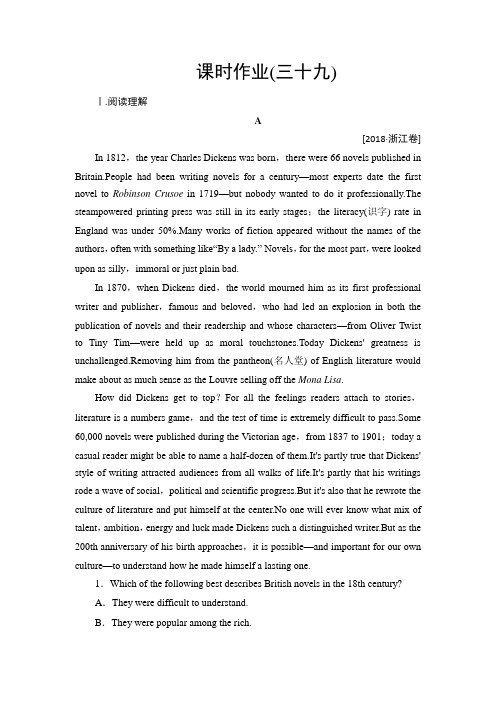
课时作业(三十九)Ⅰ.阅读理解A[2018·浙江卷] In 1812,the year Charles Dickens was born,there were 66 novels published in Britain.People had been writing novels for a century—most experts date the first novel to Robinson Crusoe in 1719—but nobody wanted to do it professionally.The steampowered printing press was still in its early stages;the literacy(识字) rate in England was under 50%.Many works of fiction appeared without the names of the authors,often with something like“By a lady.” Novels,for the most part,were looked upon as silly,immoral or just plain bad.In 1870,when Dickens died,the world mourned him as its first professional writer and publisher,famous and beloved,who had led an explosion in both the publication of novels and their readership and whose characters—from Oliver Twist to Tiny Tim—were held up as moral touchstones.Today Dickens' greatness is unchallenged.Removing him from the pantheon(名人堂) of English literature would make about as much sense as the Louvre selling off the Mona Lisa.How did Dickens get to top?For all the feelings readers attach to stories,literature is a numbers game,and the test of time is extremely difficult to pass.Some 60,000 novels were published during the Victorian age,from 1837 to 1901;today a casual reader might be able to name a half-dozen of them.It's partly true that Dickens' style of writing attracted audiences from all walks of life.It's partly that his writings rode a wave of social,political and scientific progress.But it's also that he rewrote the culture of literature and put himself at the center.No one will ever know what mix of talent,ambition,energy and luck made Dickens such a distinguished writer.But as the 200th anniversary of his birth approaches,it is possible—and important for our own culture—to understand how he made himself a lasting one.1.Which of the following best describes British novels in the 18th century?A.They were difficult to understand.B.They were popular among the rich.C.They were seen as nearly worthless.D.They were written mostly by women.2.Dickens is compared with the Mona Lisa in the text to stress________.A.his reputation in FranceB.his interest in modern artC.his success in publicationD.his importance in literature3.What is the author's purpose in writing the text?A.To remember a great writer.B.To introduce an English novel.C.To encourage studies on culture.D.To promote values of the Victorian age.[解题导语]本文是一篇记叙文,讲述了英国伟大的作家狄更斯的创作历程和他伟大的原因。
2020年高考英语 艺术生 强化训练课时作业40 天 临阵磨枪(24)

课时作业(二十二)Ⅰ.阅读理解[2019·山东烟台高三期末考试] Helicopter parents are to blame for their children still living at home at 25,according to an expert David Lancy.Professor Lancy has warned that mothers and fathers praise their children too readily,which does not adequately prepare them for modern life.In an interview,Lancy outlined our society's “WEIRD” way,which stands for Western,Educated,Industrialised,Rich and Democratic(民主的).He argued this has worrying characteristics including “raising each child as special and unique and patting them on the back for every achievement,to protect their selfconfidence.”Referring to “WEIRD”,Lancy thinks one primary reason is this fundamental viewpoint that children should never be unhappy and that if they are,that's a problem that the parent is maybe responsible for and certainly has the duty to remediate(补救).Parents totally wrap up and center on their children—an approach that is problematic.“When you said to a child,‘The horizons are limitless for you,you can do anything you want to,there's no hurry,you can take your time,’that creates a situation that you tell your kids,‘You don't have to conform_to society's or the workplace's expectations,you can continue to do what's exciting and wonderful for you,’and we end up with kids only ‘irregularly employed’ and dependent on their parents by their mid-twenties.This results in their failure to launch.”Lancy said.Lancy believes the West should look at other cultures and their more “natural” ways of raising children.“One of the greatest things we've lost,which you may become aware of in a remote village abroad,is that children have learnt from watching other people do stuff(做事),like making things,working outdoors and helping adults on the farm.”Lancy said.“If I were a parent or teacher of children now,I would make sure that they had opportunities to watch.Then even better,to join in,help out.”1.The author writes the passage with the aim of________.A.giving some advice on how to bring children upB.encouraging parents to set a good example for childrenC.showing the influences of foreign cultures on the western childcareD.warning western parents of the disadvantages of their way of raising children 2.What's the problem with the “WEIRD” way?A.Children's self-confidence will be destroyed.B.Children tend to get poorly prepared for life.C.Children will only concentrate on housework.D.Children can't afford time to fight for their ambitions.3.Which of the following can replace the phrase“conform to” in Paragraph 4?A.Do away with. B.Take advantage of.C.Live up to. D.Set aside.4.What does Lancy suggest the western parents do?A.Sign children up for courses on foreign cultures.B.Get more involved in children's growth and development.C.Force adult children to get away from home and live alone.D.Allow children more space to learn things by following suit.[解题导语]本文是一篇议论文。
- 1、下载文档前请自行甄别文档内容的完整性,平台不提供额外的编辑、内容补充、找答案等附加服务。
- 2、"仅部分预览"的文档,不可在线预览部分如存在完整性等问题,可反馈申请退款(可完整预览的文档不适用该条件!)。
- 3、如文档侵犯您的权益,请联系客服反馈,我们会尽快为您处理(人工客服工作时间:9:00-18:30)。
课时作业(二十一)Ⅰ.阅读理解A[2019·河北沧州一中模拟] That people often experience trouble sleeping in a different bed in unfamiliar surroundings is a phenomenon known as the “first-night” effect.If a person stays in the same room the following night,he tends to sleep more soundly.Yuka Sasaki and her colleagues at Brown University set out to investigate the origins of this effect.Dr Sasaki knew the first-night effect probably has something to do with how humans evolved.The puzzle was what benefit would be gained from it when performance might be affected the following day.She also knew from previous work conducted on birds and dolphins that these animals put half of their brains to sleep at a time so that they can rest while remaining alert enough to avoid predators(捕食者).This led her to wonder if people might be doing the same thing.To take a closer look,her team studied 35 healthy people as they slept in the unfamiliar environment of the university's Department of Psychological Sciences.The participants each slept in the department for two nights and were carefully monitored with techniques that looked at the activity of their brains.Dr Sasaki found,as expected,the participants slept less well on their first night than they did on their second,taking more than twice as long to fall asleep and sleeping less overall.During deep sleep,the participants' brains behaved in a similar manner seen in birds and dolphins.On the first night only,the left hemispheres(半球) of their brains did not sleep nearly as deeply as their right hemispheres did.Curious if the left hemispheres were indeed remaining awake to process information detected in the surrounding environment,Dr Sasaki re-ran the experiment while presenting the sleeping participants with a mix of regularly timed beeps(蜂鸣声) of the same tone and irregular beeps of a different tone during the night.She worked out that,if the left hemisphere was staying alert to keep guard in a strange environment,then it would react to the irregular beeps by stirring people from sleep and would ignore the regularly timed ones.This is precisely what she found.1.What do we learn about Dr Yuka Sasaki doing her research?A.She found birds and dolphins remain alert while asleep.B.She found birds and dolphins sleep in much the same way.C.She got some idea from previous studies on birds and dolphins.D.She conducted studies on birds' and dolphins' sleeping patterns.2.What did Dr Sasaki do when she first did her experiment?A.She monitored the brain activity of participants sleeping in a new environment.B.She recruited(招募) 35 participants from her Department of Psychological Sciences.C.She studied the differences between the two sides of participants' brains.D.She tested her findings about birds and dolphins on human subjects.3.What did Dr Sasaki do when re-running her experiment?A.She analyzed the negative effect of irregular tones on brains.B.She recorded participants' adaptation to changed environment.C.She exposed her participants to two different stimuli(刺激物).D.She compared the responses of different participants.4.What did Dr Sasaki find about the participants in her experiment?A.They tended to enjoy certain tones more than others.B.They tended to recognize irregular beeps as a threat.C.They felt sleepy when exposed to regular beeps.D.They differed in their tolerance of irregular tones.[解题导语]在陌生的环境中,人往往难以入睡,这种现象被称作“首夜效应”。
佐佐木博士受之前对鸟类和海豚的研究的启发对人类进行研究,发现第一次在陌生环境中睡眠时,人的大脑左半球实际上处于警惕状态。
1.C解析:细节理解题。
从第二段可知,佐佐木博士从过去对鸟类和海豚的睡眠实验中得到启发,现在将同样的实验用在人身上。
因此C项正确。
2.A解析:细节理解题。
从第二段中的“The participants each slept in thedepartment for two nights and were carefully monitored with techniques that looked at the activity of their brains.”可知,佐佐木博士的实验主要是监测参与者睡着时大脑的活动。
3.C解析:细节理解题。
从最后一段可知,佐佐木博士给实验参与者展示两种不同的蜂鸣声:规则的和不规则的。
因此C项正确。
4.B解析:推理判断题。
从最后一段中的“She worked out that,if the left hemisphere was staying alert to keep guard in a strange environment,then it would react to the irregular beeps by stirring people from sleep and would ignore the regularly timed ones.”可知,她发现如果人在陌生环境中睡眠时大脑左半球保持警惕,那么它会对不规则的蜂鸣声作出反应并把人从睡眠中叫醒,而忽视规则的蜂鸣声。
B[2019·安徽、江西等五省六校联考] Homeless people face a lot of challenges.Some of the most basic challenges,however,spring from not having regular access to clean water and cleaning stuff such as soap and shampoo.And poor personal hygiene(卫生) can be particularly troubling for homeless teens.That challenge inspired a young researcher,Leia,to invent a multi-purpose product.It would need to absorb sweat and oil from skin and hair.It would need to clean teeth.Plus,it would need to kill bacteria without being harmful to people.She wanted her ingredients to be natural and biodegradable(可生物降解的).Leia started by going to stores and looking at the ingredient lists for tooth powders,body powders and dry shampoos.Then she put together eight different trial recipes of her own.She tested each mixture to see how well it absorbed body oil and cleaned hair.To find out how they might work as a toothpaste,she tested them at removing coffee stains from eggshells.Eventually,Leia settled on three working recipes.Each contains salt and baking powder.The salt helps clean teeth and remove dirt,she notes.Baking powder helpsabsorb smells.Her three recipes' other ingredients differed.Some of those ingredients included cloves,cinnamon and chamomile.Those sorts of things give her products different tastes and smells.That would let teens choose a product based on personal preferences.Leia wants to develop her product further.“Could it be used to drive off mosquitoes?”she asks.“Or does it attract them?These are questions I want to answer next,” she notes.“Science offers a way to go about solving problems and helping people,” says Leia.And she thinks her products could benefit a broad range of people,not just the homeless.Anyone in an area with little or no access to clean water could find her products useful,she says.5.What made Leia make the product according to the text?A.Her personal experience.B.The suffering of homeless people.C.Poor personal hygiene for homeless people.D.Her curiosity about invention and helping others.6.The third paragraph mainly tells us ________.A.how Leia made the productB.how effective the product isC.what functions the product hasD.what ingredients the product has7.What can we learn about the product from the fourth paragraph?A.People can buy it in the market now.B.The product only has three varieties.C.Salt is used to clear smells and remove dirt.D.It can be custom-made to suit personal taste.8.How does Leia feel about her invention?A.It has some faults.B.It is quite satisfactory.C.It still needs improving.D.It is useful in remote area.[解题导语]无家可归的人,尤其是无家可归的青少年,面临的很大问题就是糟糕的个人卫生状况。
